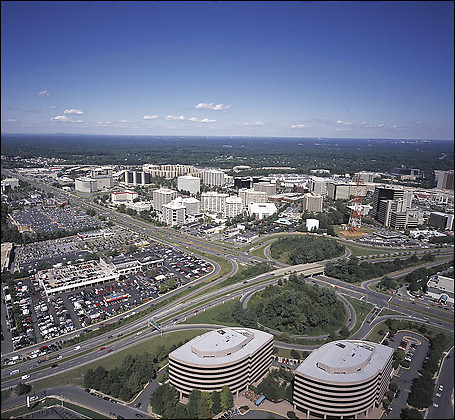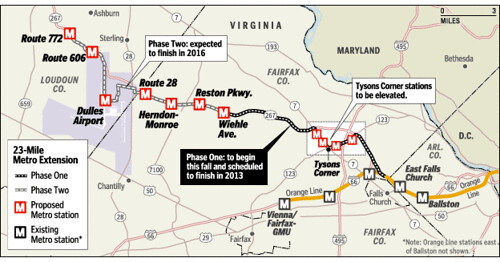Short term vs. long term thinking: transit, the Washington Examiner, Fairfax/Loudoun Counties vs. DC
 Image left: Constructing the Silver Line Metroline in Tysons Corner.
Image left: Constructing the Silver Line Metroline in Tysons Corner.On Tuesday, I went to a one-day regional conference on the regional outlook for real estate development, sponsored by the Bisnow real estate e-newsletters. There were four panels and all were quite interesting.

Tysons Corner today. Image: KGP Design Studio, LLC- Washington. This photo looks east at the interchange of Route 123 and Route 7 (Leesburg Pike) in Tysons Corner. An elevated rail line with four stations will be built down the median of Route 7. Eventually all those parking lots will be redeveloped into residential and commercial buildings, plazas, etc.
From the article:
That's a $30 billion project that does not even meet the Virginia Department of Rail and Public Transportation's own 2008 guidelines. On page 12 of "Transit Service Design Guidelines," DRPT requires a population density of at least 6,667 persons per square mile to support a heavy rail system
But the average current population between Reston and Ashburn is just 3,500 per square mile -- less than half the state's own minimum density requirement and far short of the optimal 15,000 persons per square mile found in central urban business districts.
Dulles Rail also depends upon massive new commercial and residential development clustered at or on top of the new stations. Perhaps this was a reasonable assumption back in 2002, when the preliminary environmental impact statement was being prepared, but it is a flight of fancy in a post-2008 world where commercial space in the suburbs is already overbuilt and financing for speculative ventures is virtually nonexistent.
With regard to the third paragraph, the developers see the Silver Line as absolutely essential to maintaining the submarket's relevance and competitiveness and as a place to continue to build. And the paragraph is fatuous anyway. The Tysons submarket is one of the most significant real estate markets in the U.S., even today, in the downturn.
While I am the first to discount people thinking-writing about how their communities are unique and exceptional, the fact is that DC is one of only four relatively active and somewhat thriving real estate markets in the U.S. (the others are NYC, San Francisco, and West Los Angeles), and that is the context in which policy needs to be made, not about what's happening in Phoenix or Charlotte, NC or Miami or Atlanta.
Furthermore, with regard to the population density metrics recounted in the second paragraph, again, the issue isn't what the densities are today, but what they will be in 30 years, after the transit system opens, and after land use has become more congruent with access to transit and has bulked and densified up.
I can almost guarantee that Barbara Hollingsworth, the writer of that opinion, was never in Virginia Square (now the GMU-Virginia Square subway station area) in the late 1980s, before the land was reproduced in response to the improvement in the economy and the increased value of the land, which converted marginal single family housing and low scale old strip shopping centers into multistory office and residential buildings, complemented with new retail.
According to all the panels at the Bisnow conference, the development paradigm in the United States, because of the changing preferences of not just Generation X and Y, but also aging baby boomers who don't want to have to maintain big houses and yards, or drive everywhere, is moving to mixed use and the creation of live-work-play environments.
Although the Ec. Dev. report did say this:
The Regional Economic Development subgroup was charged with overcoming obstacles to collaboration with the surrounding Greater Washington Region to achieve maximum regional economic development gains. These opportunities would greatly benefit the District by making it easier to do business here. This subgroup recommended a three-fold approach to facilitate regional growth:
o The first step is to address traffic congestion in order to increase the attractiveness of travel into and out of the District for conducting business.
BUT ALL OF THE COMMITTEE'S RECOMMENDATIONS FOCUSED ON AUTOMOBILE TRAFFIC!
The District should work with its regional partners to develop a traffic plan to prepare for the regional implications of the redevelopment.
• Reduce the amount of time people spend driving into and out of the city. The District would stand to retain and attract more businesses that demand ease of access and improvements to quality of life by easing traffic congestion. A comprehensive plan must be undertaken to identify and adjust traffic signals in a way that would net the most gain for traffic flow with the least disruption to District residents. This is one key element in an overall traffic improvement plan that will dramatically improve recruitment and retention efforts for businesses in
the District.
• Streamline major access and egress routes between the District and surrounding jurisdictions. The District Department of Transportation can work with its neighboring communities to make significant changes in the direction of streets during peak hours to move people quickly through these corridors.
• Removal of parking meters should be considered if the transportation artery should be clear throughout the day. Strict enforcement of double and no parking violations must be carried out in a consistent and timely manner. The District should begin to identify the major intersections that provide access and egress from surrounding jurisdictions. These intersections should be staffed with trained traffic professionals to immediately enhance traffic flow. Consideration should be given to securing cost recovery from appropriate neighboring jurisdictions.
Meanwhile all the developers in the area impacted by the Silver Line are re-organizing their focus around transit. The Northern Virginia Growth Machine knows where it's at.
Labels: economic development, Growth Machine, real estate development, sustainable land use and resource planning, transportation planning




0 Comments:
Post a Comment
<< Home